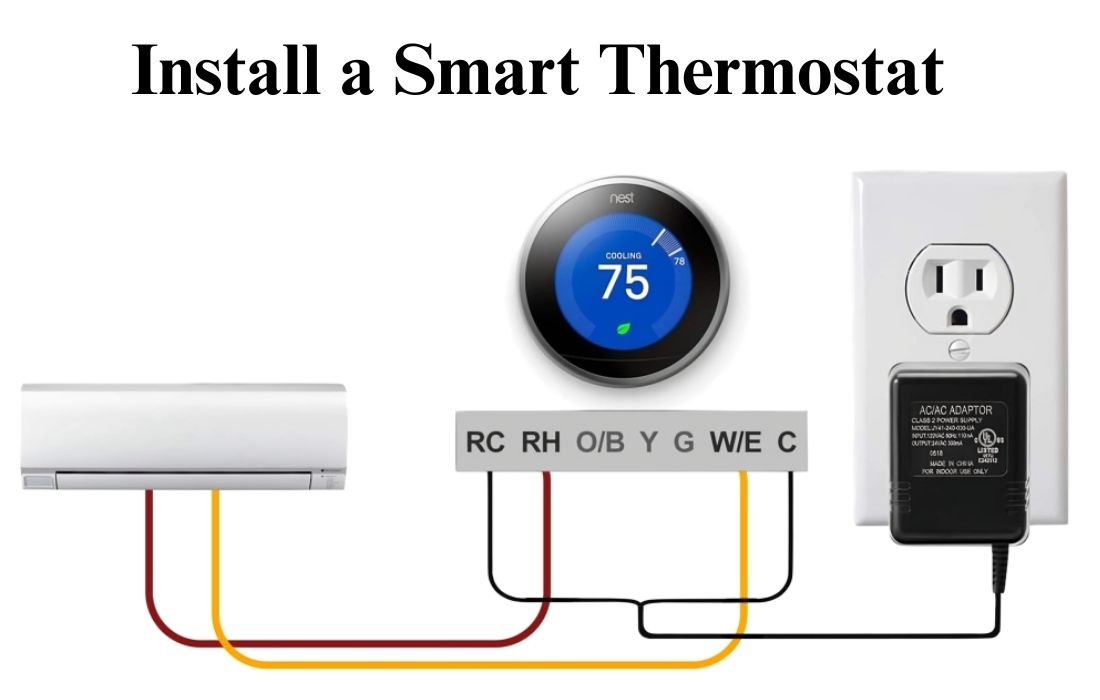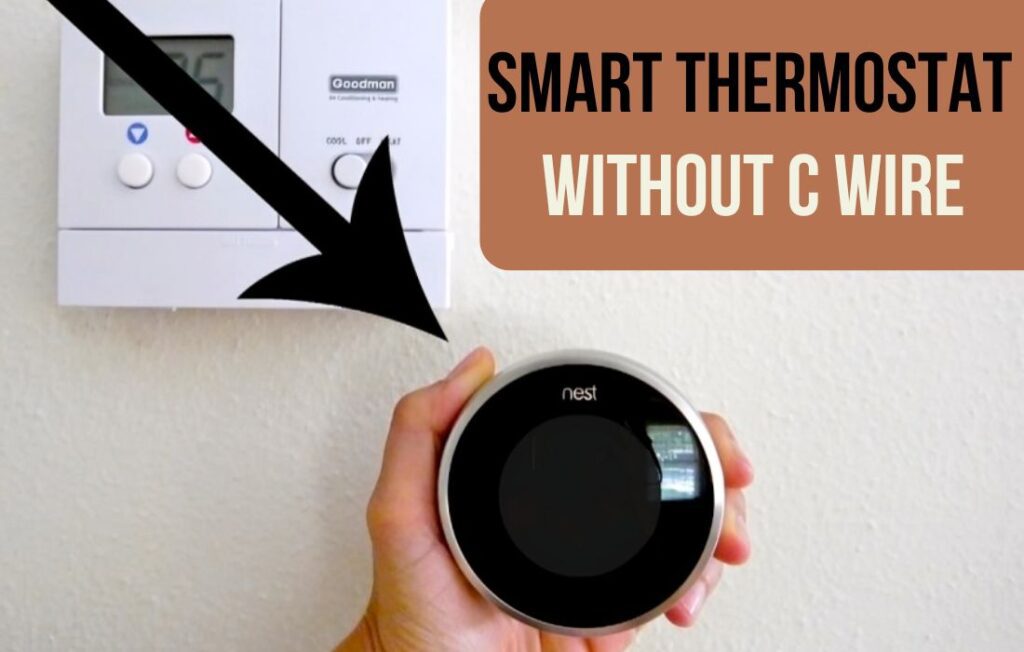Great day! To upgrade to a smart thermostat in 2024 however, if your HVAC framework lacks a C wire, you’ve come to the perfect location. It may appear to be difficult to install a smart thermostat without a C wire, but it is conceivable to do the process with the necessary preparation and the suitable adaptor. In this article, we’ll walk through everything you want to know to install a C without wire smart thermostat in a couple of easy advances. We’ll cover compatibility, choosing the right adapter, wiring, arrangement, and more. With the assistance of this aide, you’ll join the universe of smart home technology and regulate your home’s temperature in no time. Ready to get everything moving? upgrade your HVAC system with a smart thermostat, even without a C-wire! step by step on how to install a smart thermostat without a C-wire.
Why Do Smart Thermostats Need It and What Is a C Wire?
A C wire, or common wire, gives continuous capacity to your thermostat. For features like touchscreens, temperature sensors, and Wi-Fi connectivity to work, smart thermostats should always have the option to operate. Most smart thermostats won’t function without a C wire.
Do You Have a C Wire? (Smart Thermostat Without C Wire)
To check if you have a C wire, locate your existing thermostat and check whether it has a wire labeled “C”, “Com”, or “Common”. Assuming this is the case, fortune has smiled on you – your HVAC framework furnishes constant influence and is compatible with most smart thermostats.
Assuming that there’s no C wire, don’t lose trust. Some HVAC frameworks give power through the thermostat wires, in which case you may have the option to reuse an unused wire as the C wire. You’ll have to check with your HVAC manufacturer to determine assuming this is conceivable. As a last hotel, you can install a C wire or utilize a C wire adapter to give external capacity to a smart thermostat.
Do You Need a C Wire Adapter?
A C wire adapter, also called a power extender, connects to your existing thermostat wires and gives an additional C wire to drive your smart thermostat. The adapter gets its power from your furnace or air handler, so installation is straightforward for most DIYers. Notwithstanding, C wire adapters don’t work for all HVAC frameworks, so check with the adapter specifications before purchasing.
If the C wire adapter won’t work or you’re not comfortable with Do-It-Yourself electrical work, you’ll have to have an HVAC technician install another C wire. They can run the C wire from your furnace to the thermostat location and connect everything appropriately. While a professional installation costs more, it guarantees your smart thermostat will function as intended in the indefinite future.
With some investigation into your HVAC wiring and potential adapters or professional installation, most homes can uphold a smart thermostat – even without a traditional C wire. A little patience and expertise can assist you with joining the universe of Wi-Fi-connected temperature control.
Can I Install? (A smart Thermostat Without C Wire)

A smart thermostat may indeed be installed without a C wire or common wire. Many smart thermostats are intended to work without a C wire just barely of force from your HVAC framework. Nonetheless, there are a couple of things you’ll want to consider before installing a smart thermostat sans C wire.
Check Your HVAC System Compatibility
The primary thing you’ll want to do is check that your HVAC framework is compatible with the smart thermostat you want to install. Most major smart thermostat brands like Home, Ecobee, and Honeywell offer C without wire choices, but you’ll in any case want to confirm your HVAC gear is maintained. If your HVAC framework is more seasoned, it may not be compatible with smart thermostats that needn’t bother with a C wire.
You May Need a Power Extender
A few smart thermostats can pull sufficient power from your HVAC framework to operate normally without a C wire. In any case, on the off chance that your HVAC framework can’t give sufficient power, the thermostat may drain its battery quickly or experience different issues. In these situations, you’ll have to install a power extender, which gives additional capacity to the thermostat from your furnace.
Check for Compatibility Issues
Your smart thermostat may encounter compatibility problems, such as erroneous temperature readings or trouble controlling your HVAC equipment, even if it turns on without a C wire. The thermostat regularly losing power or connectivity, problems managing your heating/cooling gear, or erroneous interior temperature readings are a few indicators that you may have a compatibility issue.
If you notice these or different issues, you’ll probably have to install a C wire to determine them.
You Can Always Add a C Wire Later
If you install a smart thermostat without a C wire and experience issues, sit back and relax — you can always add a C wire later. Installing a C wire after the fact may require some rewiring, yet it’s generally expected an easy fix that will tackle any power or compatibility issues with your smart thermostat.
Alternatives to Using a C Wire for Your Smart Thermostat
Battery-controlled smart thermostats
Many smart thermostats like the Ecobee Smart Thermostat and Home Learning Thermostat have an underlying rechargeable battery so they can run without a C wire. The battery is recharged by the power utilized from the Y terminal (cooling) and W terminal (heating) on your HVAC unit. The disadvantage is that the battery should be replaced every 3-5 years, yet for many mortgage holders, it’s a basic arrangement without having to install any new wiring.
Power stealing (Smart Thermostat Without C Wire)
Some smart thermostats like the Ecobee Smart Thermostat and Home Learning Thermostat can draw power from your HVAC framework using a strategy called “power stealing” or “power sharing”. They take a small electrical charge from the Y and W terminals that control your cooling and heating to drive the thermostat. This strategy works for most HVAC frameworks, yet in some cases can reduce the voltage provided to your HVAC unit enough to cause issues. If you experience issues with your HVAC after installation, you may have to install a C wire.
Sensitive wireless devices
Installing wireless far-off sensors in your home is a possibility for smart thermostats such as the Ecobee Smart Thermostat. To give temperature measurements to various rooms and zones, these sensors wirelessly link to the thermostat. There is a compelling reason need to install wires because they are battery-operated. The main thermostat needs power, either from a C wire, rechargeable battery, or power stealing strategy. Be that as it may, wireless sensors give you greater adaptability in controlling the temperatures in specific areas of your home.
Smart thermostat alternatives
You should think about a smart thermostat alternative if none of the techniques for installing a smart thermostat without a C wire work for your arrangement. While they lack the more sophisticated features of smart thermostats, such as remote access and learning capabilities, programmable thermostats give some basic scheduling choices to assist with saving energy. Smart vents and vent covers, similar to the Sharp Home Smart Vent, give zone control in your home. Smart air purifiers can also integrate with smart home frameworks. On the off chance that a smart thermostat isn’t working with your HVAC framework, such gadgets could function admirably for you.
How to Install a Smart Thermostat Without C Wire

A common “C” wire gives continuous ability to smart thermostats. Notwithstanding, many homes lack a C wire, making installation tricky. Simply relax, there are a couple of workaround options so you can in any case partake in the advantages of a smart thermostat.
Use Batteries
Some smart thermostats like the Ecobee Smart Thermostat and Home Learning Thermostat offer a battery-fueled choice so they can function without a C wire. The thermostat will utilize the power from the batteries to operate and charge itself when your HVAC framework is running. The batteries typically should be replaced every 1-2 years. While not the best arrangement, it can work in a pinch.
Install a Power Extender Kit: (Smart Thermostat Without C Wire)
If you want a more permanent arrangement without running new wires, you can install a power extender pack, also known as a “C-wire unit” or “C-wire adapter”. This pack connects to your existing thermostat wires to draw power and give a C-wire connection to your smart thermostat. The packs are relatively easy to install following the instructions given. Popular options include the Sensi C-Wire Adapter and Venstar Add-A-Wire.
Run New Thermostat Wire
As a last resort, you may have to install a new thermostat wire between your furnace/air handler and the thermostat location. This choice gives the most reliable arrangement yet in addition, requires cutting into walls to run the additional wire. If you’re comfortable doing minor electrical work, you can run the wire yourself. Otherwise, it’s ideal to recruit an HVAC technician to appropriately install the new thermostat wire.
With one of these options, you’ll have the option to installSmart Thermostat Without C Wire and gain more control over the temperature in your home. The ability to remotely screen and adjust the temperature from your cell phone can assist with reducing energy usage and give more comfort.
Conclusion
So there you have it, a bit-by-bit walkthrough on installing a Smart Thermostat Without C Wire in 2024 without a C wire. At this point, you ought to feel engaged to take on this project yourself. With a brief period and real effort, you’ll be well-headed to energy savings and home automation ecstasy. Simply make sure to switch off the power, prep the wires, mount the baseplate, connect the wires, attach the thermostat, and configure the settings. Try not to let a lack of C wire keep you down. You got this! With the right preparation and patience, you can have the latest smart thermostat running in your home. Check it out and take control of your home’s temperature. Your wallet and the planet will thank you.


